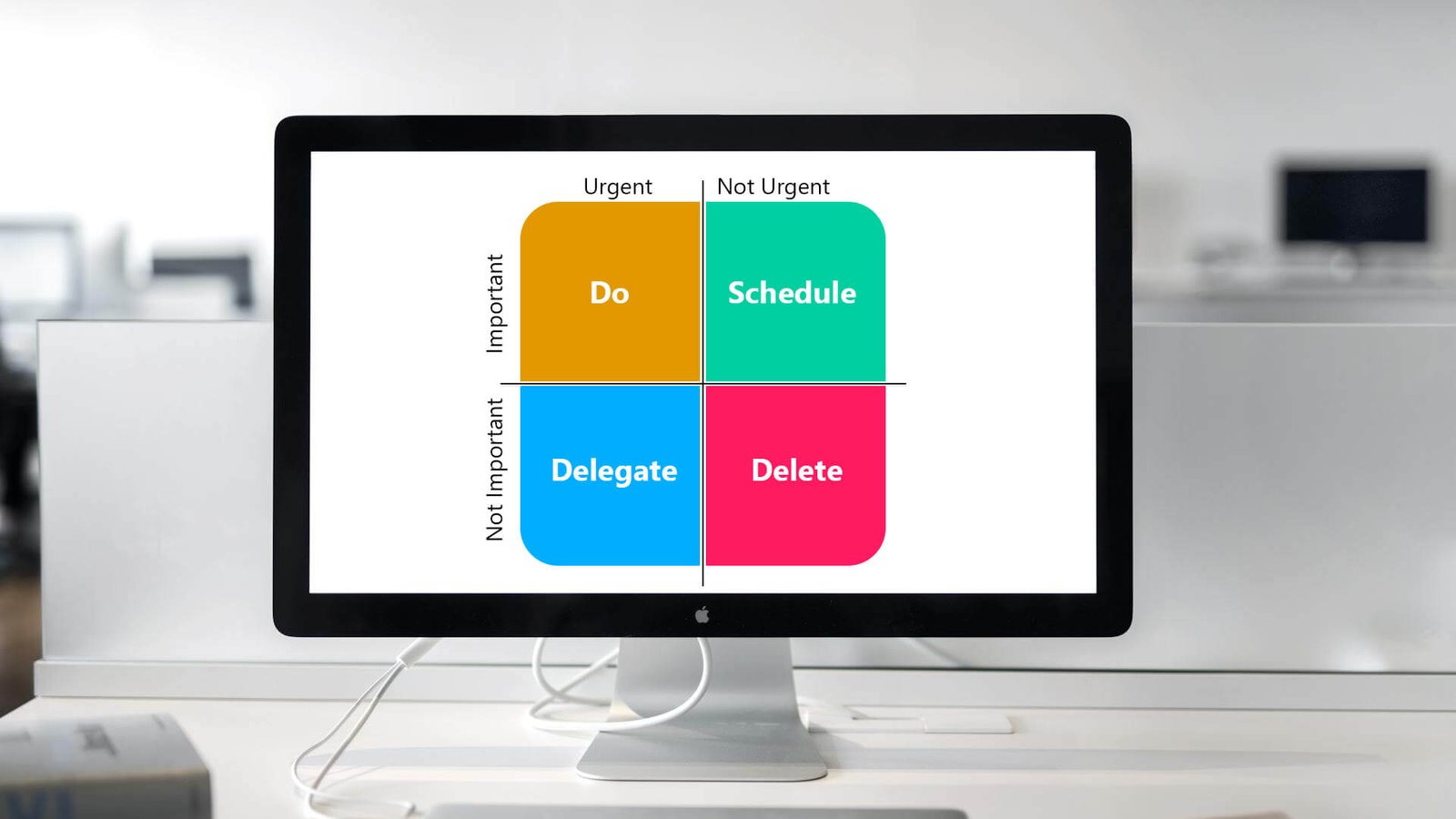
Mastering Productivity with the Eisenhower Matrix: An In-Depth Guide to Prioritizing Tasks
Managing time effectively and staying productive often feel like a daunting challenge. The Eisenhower Matrix, a strategic tool developed by Dwight D. Eisenhower, the 34th President of the United States, offers a systematic approach to task prioritization that can dramatically enhance productivity and decision-making.
This article covers the Eisenhower Matrix in detail, providing a thorough understanding of its principles, benefits, and practical strategies for implementation. Whether you’re a busy professional, a student, or anyone striving to optimize productivity, this guide will help you harness the power of the Eisenhower Matrix to streamline your tasks, achieve your goals, and maximize your efficiency.
What Is the Eisenhower Matrix?
The Eisenhower Matrix, also known as the Urgent-Important Matrix, is a prioritization tool designed to help individuals and organizations categorize tasks based on their urgency and importance. It divides tasks into four distinct quadrants:
1. Quadrant I: Urgent and Important
Tasks that require immediate attention and are critical to achieving your goals. These tasks are both time-sensitive and crucial to your responsibilities.
2. Quadrant II: Important but Not Urgent
Tasks that are essential for long-term success and contribute significantly to your goals, but do not require immediate action. These tasks often involve planning, strategy, and personal development.
3. Quadrant III: Urgent but Not Important
Tasks that demand immediate attention but are not crucial for achieving your long-term objectives. These tasks may be distractions or interruptions that require quick action but have limited impact on your overall goals.
4. Quadrant IV: Not Urgent and Not Important
Tasks that have little or no impact on your goals and are often considered distractions or low-priority activities. These tasks do not contribute significantly to your productivity and can be minimized or eliminated.
Origins and Concept
The Eisenhower Matrix is named after Dwight D. Eisenhower, who was renowned for his exceptional time management skills and effective decision-making. Eisenhower’s approach to prioritization was based on the principle of distinguishing between tasks that are urgent and those that are important. The matrix provides a clear framework for evaluating tasks and making strategic decisions about how to allocate your time and resources.
The concept behind the matrix is grounded in the idea that not all tasks are created equal. By categorizing tasks into four quadrants, individuals can focus on what truly matters, avoid getting caught up in less important activities, and ensure that their time is spent on high-impact tasks.
Why the Eisenhower Matrix Works
1. Clarifies Priorities
The Eisenhower Matrix offers a clear and structured way to identify and prioritize tasks based on their urgency and importance. By categorizing tasks into distinct quadrants, you gain clarity on what needs immediate attention and what can be scheduled for later, helping you focus on the most critical activities.
2. Enhances Decision-Making
The matrix provides a systematic approach to decision-making by distinguishing between tasks that are urgent and those that are important. This helps you make informed decisions about how to allocate your time and resources, ensuring that you address high-priority tasks effectively.
3. Reduces Stress
Effective prioritization through the Eisenhower Matrix can significantly reduce stress by providing a clear structure for managing responsibilities. By focusing on high-priority tasks and avoiding distractions, you can manage your workload more effectively and reduce feelings of overwhelm.
4. Improves Time Management
The matrix promotes efficient time management by encouraging you to address urgent and important tasks first. By organizing tasks into quadrants, you can allocate your time more effectively, ensuring that critical tasks are completed on time and that long-term goals are pursued systematically.
5. Boosts Productivity
Prioritizing tasks based on urgency and importance leads to increased productivity. By focusing on tasks that have the greatest impact on your goals and responsibilities, you can achieve significant progress and make the most of your time and efforts.
Implementing the Eisenhower Matrix
1. Identify and List Your Tasks
Create a Comprehensive Task List: Start by listing all the tasks and responsibilities you need to complete. This includes both personal and professional tasks, ensuring a holistic view of your workload.
Assess Each Task: Evaluate each task based on its urgency and importance. Determine whether the task falls into Quadrant I, II, III, or IV. Consider factors such as deadlines, impact on goals, and overall significance.
Categorize Tasks: Use the Eisenhower Matrix to categorize each task into one of the four quadrants. This process helps you prioritize your activities and decide how to manage them effectively.
2. Prioritize Tasks
Focus on Quadrant I Tasks: Begin by addressing tasks in Quadrant I, which are both urgent and important. These tasks require immediate attention and should be prioritized to ensure timely completion.
Schedule Quadrant II Tasks: Plan and schedule tasks in Quadrant II, which are important but not urgent. Allocate dedicated time for these tasks to ensure that they are completed and contribute to your long-term goals.
Delegate Quadrant III Tasks: For tasks in Quadrant III, which are urgent but not important, consider delegating them if possible. If delegation is not an option, handle these tasks efficiently to minimize their impact on your priorities.
Minimize Quadrant IV Tasks: Limit time spent on tasks in Quadrant IV, which are neither urgent nor important. These tasks often serve as distractions and should be minimized to focus on more meaningful activities.
3. Create an Action Plan
Develop a Detailed Schedule: Based on the prioritization of tasks, create a detailed schedule that allocates time for Quadrant I and II tasks. Use tools like calendars, planners, or digital scheduling apps to organize your tasks.
Set Clear Deadlines: Establish deadlines for completing tasks in Quadrant I and II. Deadlines provide structure and help ensure timely completion of important activities.
Monitor and Adjust: Regularly review your task list and matrix to monitor progress and make adjustments as needed. Stay flexible and adapt your plan based on changing priorities or new tasks that arise.
4. Review and Reflect
Evaluate Your Priorities: Periodically review your task list and Eisenhower Matrix to evaluate how effectively you’re managing your priorities. Assess whether tasks are being categorized correctly and if any adjustments are needed.
Reflect on Time Management: Reflect on how well you’re managing your time and whether you’re focusing on high-priority tasks. Identify areas for improvement and make adjustments to enhance your productivity.
Celebrate Achievements: Acknowledge and celebrate your accomplishments, especially for tasks in Quadrant I and II. Celebrating achievements reinforces positive behavior and motivates you to continue working toward your goals.
Success Stories
| Michelle, the Project Manager |
| Michelle, a project manager in a busy tech company, faced challenges in managing multiple projects and tight deadlines. By implementing the Eisenhower Matrix, she categorized her tasks into quadrants and prioritized her activities accordingly. Focusing on urgent and important tasks allowed her to meet deadlines and successfully complete projects. The matrix helped Michelle streamline her workload, reduce stress, and improve her overall productivity. |
| Michael, the Entrepreneur |
| Michael, an entrepreneur running a startup, struggled with balancing day-to-day operations and long-term business development. Using the Eisenhower Matrix, he categorized tasks related to business growth into Quadrant II and scheduled dedicated time for these activities. This approach enabled Michael to make significant progress on strategic goals while efficiently managing urgent tasks. The matrix helped him achieve a better balance between immediate needs and long-term vision. |
| Lisa, the Academic Researcher |
| Lisa, an academic researcher juggling research activities and teaching responsibilities, needed an effective way to manage her time. By applying the Eisenhower Matrix, she identified and prioritized her research tasks in Quadrant I and II. This approach allowed Lisa to stay focused on critical research activities, meet deadlines, and achieve important milestones. The matrix helped her navigate her academic responsibilities and make meaningful progress in her research. |
| Tom, the Marketing Executive |
| Tom, a marketing executive, struggled with managing a high volume of tasks and deadlines. He used the Eisenhower Matrix to categorize his tasks and prioritize them based on urgency and importance. By focusing on Quadrant I tasks and scheduling Quadrant II activities, Tom was able to improve his time management, increase his productivity, and meet marketing campaign deadlines more effectively. |
| Jessica, the Freelance Writer |
| Jessica, a freelance writer with multiple clients, needed a way to manage her workload efficiently. She applied the Eisenhower Matrix to prioritize her writing tasks and client projects. By categorizing tasks into quadrants and focusing on urgent and important deadlines, Jessica was able to deliver high-quality work on time, build stronger client relationships, and enhance her productivity. |
Tips for Success
1. Be Specific
Define Tasks Clearly: Clearly define each task to accurately assess its urgency and importance. Avoid vague descriptions and ensure that tasks are specific, actionable, and measurable.
Set Clear Goals: Establish clear, measurable goals and objectives to guide your task prioritization. Clear goals help you determine which tasks align with your long-term aspirations and provide a sense of direction.
Prioritize Wisely: Make informed decisions about prioritization based on the impact and relevance of each task. Focus on tasks that contribute significantly to your goals and responsibilities, and avoid getting bogged down by less important activities.
2. Use Tools and Resources
Utilize Digital Tools: Use digital tools and apps to create and manage your Eisenhower Matrix. Tools like Trello, Asana, or Microsoft To-Do can help you organize, track, and visualize your tasks effectively.
Leverage Time Management Apps: Employ time management apps that integrate with your Eisenhower Matrix to schedule and track tasks. Apps like Todoist, Google Calendar, or Notion can assist with task organization and provide reminders.
Seek Support: Seek input from colleagues, mentors, or managers when prioritizing tasks. External perspectives can provide valuable insights, help ensure accurate categorization, and offer support in managing complex responsibilities.
3. Maintain Flexibility
Adapt to Changes: Be flexible in adjusting your priorities based on changing circumstances, new tasks, or unexpected developments. Adapt your Eisenhower Matrix to accommodate evolving needs and ensure continued progress.
Handle Interruptions: Address interruptions promptly and assess their impact on your priorities. Use techniques like time blocking or the Pomodoro Technique to manage interruptions and maintain focus on critical tasks.
Balance Responsibilities: Balance your focus between urgent tasks and long-term goals. Ensure that you allocate time for both immediate needs and strategic activities to achieve a well-rounded approach to productivity.
4. Review and Adjust Regularly
Conduct Regular Reviews: Regularly review your Eisenhower Matrix to assess task prioritization, progress, and overall effectiveness. Make adjustments as needed to stay aligned with your goals and priorities.
Reflect on Effectiveness: Reflect on how well the matrix is helping you manage tasks and priorities. Use this reflection to identify areas for improvement, refine your approach, and enhance your time management strategies.
Celebrate Progress: Recognize and celebrate your achievements, especially for tasks in Quadrant I and II. Celebrating progress reinforces positive behavior, boosts motivation, and encourages continued success.
Common Challenges and Solutions
1. Difficulty Categorizing Tasks
| Challenge | Accurately categorizing tasks into the appropriate quadrants can be challenging, especially when tasks have overlapping characteristics. |
| Solution | Use specific criteria to assess the urgency and importance of each task. Consider deadlines, impact on goals, and overall significance. Seek feedback from colleagues or mentors to ensure accurate categorization. |
2. Managing Overwhelm
| Challenge | Feeling overwhelmed by the volume of tasks and responsibilities can make it difficult to prioritize effectively and manage your workload. |
| Solution | Break tasks into smaller, manageable components and tackle them sequentially. Use the Eisenhower Matrix to focus on high-priority tasks and manage your workload more effectively. |
3. Balancing Immediate and Long-Term Goals
| Challenge | Balancing immediate needs with long-term goals can be challenging, especially when faced with urgent tasks that require immediate attention. |
| Solution | Prioritize tasks based on their impact and alignment with your goals. Allocate dedicated time for long-term goals while managing urgent tasks efficiently. Use time management techniques to balance immediate and strategic activities. |
4. Avoiding Procrastination
| Challenge | Procrastination can hinder progress on important tasks and affect overall productivity, especially when faced with challenging or less enjoyable tasks. |
| Solution | Use time management techniques, such as time blocking, the Pomodoro Technique, or the Two-Minute Rule, to stay focused and avoid procrastination. Break tasks into manageable steps and address them systematically. |
5. Handling Interruptions
| Challenge | Interruptions and distractions can disrupt your focus and impact task prioritization, making it difficult to stay on track with your goals. |
| Solution | Minimize distractions and create a focused work environment. Use techniques like time blocking or the Pomodoro Technique to manage interruptions and maintain concentration. Establish boundaries and communicate your availability to minimize disruptions. |
6. Dealing with Perfectionism
| Challenge | Perfectionism can lead to delays and inefficiencies, especially when tasks are over-analyzed or overly refined. |
| Solution | Set realistic standards and deadlines for completing tasks. Focus on achieving progress rather than perfection. Use the Eisenhower Matrix to prioritize tasks based on their importance and impact, rather than striving for perfection in every detail. |
7. Managing External Demands
| Challenge | External demands and unexpected tasks can disrupt your priorities and impact your ability to focus on high-priority activities. |
| Solution | Use the Eisenhower Matrix to reassess and adjust your priorities based on new demands. Delegate or reschedule less critical tasks as needed to manage external demands effectively and stay focused on your core responsibilities. |
Conclusion
The Eisenhower Matrix is a powerful tool for enhancing productivity and managing time effectively. By categorizing tasks based on their urgency and importance, you can make informed decisions about how to allocate your time and resources. This article has explored the principles of the Eisenhower Matrix, provided practical strategies for implementation, and offered solutions to common challenges.
Embrace the Eisenhower Matrix as a transformative approach to achieving your goals and optimizing your productivity. Share your experiences and insights on using the Eisenhower Matrix in the comments below, and let us know how this tool has impacted your approach to time management and task prioritization. With the right approach and commitment, the Eisenhower Matrix can help you achieve greater efficiency, reduce stress, and make meaningful progress toward your objectives.



